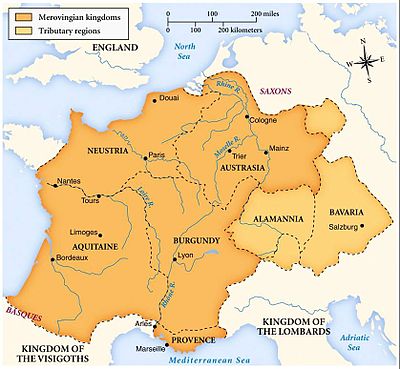The Church in the Merovingian Period
‘The Frankish reign of the Merovingians… was an age bathed in blood and murder, full of the most dreadful tragedies, at the same time replete with believing zeal and holiness’. —Franz Zach, Catholic
‘No one in history ever founded so many monasteries again…’ —P. Lasko
‘… a bloody period of the Frankish Church’. —A. Huack
‘Naked violence reigned everywhere… the continually renewed spectacle of almost unspeakable crimes’. —Daniel Rops, Catholic
 In the Merovingian period Gaul was already fundamentally Christian, and became increasingly Christianised.
In the Merovingian period Gaul was already fundamentally Christian, and became increasingly Christianised.
It is true that its oldest inscription, certainly Christian, only dates from the year 334 and Lyon; but today it has been lost. And, indeed, at that time Christians were still a minority, even in the cities where the Christian emperors, and of course their Christian collaborators too, lived.
In any case, the spread of Christianity in Gaul had already made rapid progress, and it seems that by 250 there were already bishops there: in Toulouse Saint Saturninus, Arles Marcianus, Paris Saint Dionysius and Narbonne, where a few decades later there is evidence of a Christian cemetery. And in any case, these bishops, like those of Tours, Clermont and Limoges, were in no way delegates of Rome. The alleged Roman mission is undoubtedly a falsehood of the 5th or 6th century: an attempt by the papacy to assert its authority. And, naturally, such a falsehood also had to ensure the apostolic origin of these Gallic bishoprics. The same motif is also found in Spain.
But in the 4th century, episcopal sees already swarmed Gaul. In the Belgian-Germanic territories, too, there are more and more bishoprics: in Orléans, Verdun, Amiens, Strasbourg, Speyer, Worms, Basel, Besançon, and Chalon-sur-Saone. Not to mention older ones, such as those of Trier, Metz and Cologne, all of which—like those of Tongeren and Mainz—falsely claimed to be foundations of disciples of the apostles.
At the end of the 5th century, when Gaul became the epicentre of Western history, some 115 bishops ministered there, almost exclusively in cities. And by the end of the 6th century, Gaul was occupied by 11 metropolitan sees with 128 dioceses: Arles had 24 bishoprics, Bordeaux 17 and Bourges 9, Lyon 10, Narbonne 7, Reims 12, Rouen 9, Sens 7, Tours 8, Trier 9 and Vienne 5.
A kind of holy cancerous ulcer
This period, in which Christianity infected the Germanic world, the dominance of the Frankish nobility was forged and the typical medieval society of royalty, church and nobility emerged from the 5th century, was an era characterised, as few others had been, by unbridled passions and bloody atrocities, betrayals and untold crimes.
Palace intrigues, dynastic quarrels, incessant betrayals, the unscrupulous elimination of kings and princes (the average lifespan of the Merovingians was 24.5 years) and the bestial campaigns to wipe out entire families were as commonplace as drunkenness and epidemics, famines and plundering. The history of Gaul in the Merovingian period is a unique chronicle of barbarism. Administration, trade and agriculture all collapsed to a greater or lesser extent, and crime triumphed to the full.
There has hardly ever been a more anarchic period in Europe than these early centuries of the Middle Ages. And yet the clergy didn’t think of forbidding intervention. The prelates were not overly incited by the desire for martyrdom. And the Church itself came to enjoy all the plundering and pillaging. Its real estate, which had already increased in the 4th century, then increased immeasurably.
Already in the 6th century its wealth grew ‘to infinity’ (Dopsch). ‘During the Merovingian period no memorable rebellion of ecclesiastical authority ever broke out, simply because the Church was not in opposition to the civil power, but collaborated closely with it’ (Bodmer). Indeed, the Frankish bishops participated in the power struggles between kings and grandees, ‘albeit with material and not spiritual weapons’ (Bund), going so far as ‘the de facto usurpation… of instruments of state and military power’ (Prinz).
In reality the high clergy and the first nobility are the driving forces of that immense confusion. In the imperium, they set up semi-independent powers, causing it to lurch either to one side or the other in permanent crises, which led to chaos.
There have never been so many saints, perhaps except for the martyrial era with its squadrons of so-called blood witnesses. In the 7th century alone, no fewer than eight hundred have been counted. Moreover, ‘that Merovingian century, so decisive for the development of the West’, found ‘a spiritual expression appropriate to the age in the lives of saints’, hagiography having experienced ‘an undoubted increase’.
The saints enjoyed high prestige. They built great monasteries with pompous churches. Like their biographers, they had an unmistakably positive attitude towards the monarchy and the nobility, most of them coming from aristocratic families. One could almost have the impression that ‘nobility was the anteroom to sainthood’, and one could speak of the ‘self-sanctification’ of Merovingian noble society (Prinz).
This was just as beneficial to the Church as the caste of the lords. Its desire for political-charismatic domination, which had been damaged by the apostasy of the old faith, was strengthened by the resources of the new faith providing Christian legitimisation. At the same time, however, the epoch, and especially the 7th century, was characterised by a ‘flowering’ of hagiography and a taste for the miraculous, which amounted to ‘the greatest falsification of historicity’, and consequently led to ‘the state of prostration of Western historiography’. All in all, this ‘was the result of a barbarisation, after the ancient stream had dried up’ (Scheibelreiter).